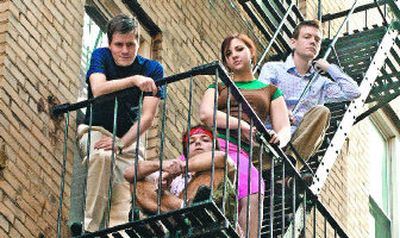Apartment Theater

NEW YORK – The air is filled with uncertain expectancy as purple-haired 20-somethings, urbane 50-somethings and those in between stream into the loft.
The 40 or so people exchange smiles without quite mingling. Some head for the ping-pong table, while others put on lipstick or pull beers from the fridge.
One man tries to gauge the loft’s occupants by decoding the post-collegiate minimalist decor: an entry-level sofa with a beanbag chair, utility shelves supporting books that range from Grisham to Nietzsche.
The atmosphere is something between the first hour of a party and a real-estate open house, and it is, in fact, a bit of both. It’s the set on this recent evening of a form-meets-function theatrical production called “The Sublet Experiment.”
The play, a modern comedy of romance and real estate, has been performed since November in a roving series of New York City apartments and lofts, garnering something of a reputation as a novelty even in a city full of theatrical innovation.
As The New York Times put it, the production offers “the most titillating peep show in New York: other people’s apartments.”
Ranging from sprawling lofts to small one-bedrooms – all but one occupied, and offered for free – the play has appeared in three of the city’s five boroughs and across the Hudson River in Hoboken, N.J.
The set consists of whatever there is in the host’s apartment, except for a few imported props. The audience has ranged from 12 to 40 people, depending on the size of the apartment.
The audience sits around the space, and the action unfolds with an almost unnerving immediacy and intimacy. While spectators are politely reminded that they are just that – not participants – the setup doesn’t let the audience fade into the comfortable distance and darkness of a conventional theater.
The effect is something like watching a psychology experiment through a conspicuous one-way mirror, knowing that everyone on both sides is only pretending not to be seen.
“You always hope, when you’re writing a play, to draw the audience into the world you create. And in some ways, this is cheating,” says “Sublet Experiment” playwright Ethan Youngerman, 29, who has had two other full-length plays performed in New York.
But if the set up makes spectators feel like voyeurs – and it’s hard not to, while listening to intimacies in a stranger’s living room – it is not without artistic purpose.
Financial considerations initially inspired the idea of producing “The Sublet Experiment” in apartments, but Youngerman and director Michelle Tattenbaum quickly saw producing the play in peoples’ homes as a reflection of its themes of living in borrowed spaces.
The cunning, swift-footed comedy begins with an offer to share an apartment in exchange for sexual favors, and goes on to explore the assumptions people draw about others from their surroundings.
“That issue of place having some impact on someone’s sense of identity seemed like a really great parallel to doing a play in different apartments,” says Tattenbaum, 30, who met Youngerman when they were undergraduates at Yale University in the 1990s.
“The Sublet Experiment” furthers a long history of theater in art galleries, streets and other nontraditional spaces, but it is something of a departure in its own nomadic, ad-hoc direction, says Joe Salvatore, a New York University education-theater professor.
The shifting, unpredictable surroundings – phones and buzzers have occasionally rung unbidden – mean the actors “have to make new choices every time,” Salvatore says.
Since the first two apartments, the cast hasn’t run full rehearsals in each new environment, although they do spend perhaps an hour figuring out how to fit some key moments and elements into the new space.
“I love the fact that the show refreshes itself every week,” says actor Adam Hyland, 28.
Tattenbaum’s and Youngerman’s friends and others have volunteered 13 apartments so far, enough to keep the show going at least through the end of April; the production rented a loft for March to take a break from moving around.
The show, performed four nights a week at $25 a ticket, has yet to advertise. Its audience has been drawn so far from word of mouth, e-mail lists and news coverage, Tattenbaum says.
Hosts get free tickets, and the production staff supplies chairs for the audience, refreshments, clean-up, even toilet paper.
The producers advise hosts to clear their living rooms of valuables that might be easily filched, but nothing has been stolen or damaged to date, Tattenbaum says. The production nonetheless carries $1 million in insurance for injuries and property damage.
“It’s really funny to tell people about it because everybody is fascinated by the idea,” says Noelle Teagno, who hosted the play in December in the sizable one-bedroom she and husband Graham Stevens, both actors, share in the Astoria section of Queens.
Still, she acknowledges: “It’s a little weird to come home and see a line of people waiting for your bathroom.”